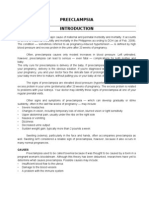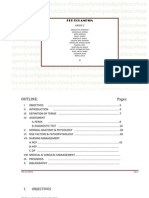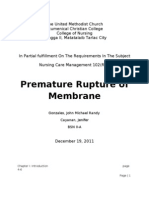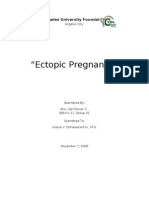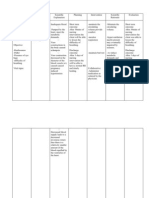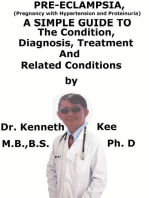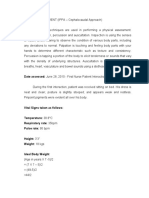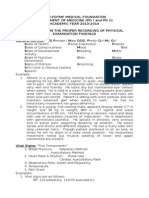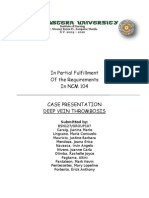Preeclampsia Case Study
Preeclampsia Case Study
Uploaded by
samangelo94Copyright:
Available Formats
Preeclampsia Case Study
Preeclampsia Case Study
Uploaded by
samangelo94Original Title
Copyright
Available Formats
Share this document
Did you find this document useful?
Is this content inappropriate?
Copyright:
Available Formats
Preeclampsia Case Study
Preeclampsia Case Study
Uploaded by
samangelo94Copyright:
Available Formats
16
B. PHYSICAL EXAMINATION
Vital Signs: Temperature: 36.5 oC Respiratory Rate: 21 cpm
Pulse Rate: 88 bpm. Blood Pressure: 150/90 mmHg.
General Observations: Received patient lying in bed, conscious, coherent and mentally-oriented to time, people and place. Patient has fair skin with stitches on the incision site of the lower abdomen. Overall, patient is in a normal appearance.
Skin: Patient has fair, moist warm and smooth skin. Its turgor is within 1 to 2 seconds. Hair: Patient has long, black hair. It is distributed evenly. It is smooth and silky. Scalp: The scalp is free from lesions. Tenderness and masses are not noted. Nails: Nails of patient are pinkish in color. It is a bit square. It is smooth. Capillary refill is 2 to 3 seconds. No lesions found. Skull: Patient has a normocephalic head, symmetrical and no masses were found. Face: The face is able to do any impressions or expressions. It is oblong-shaped, symmetrical and free from edema and/or masses.
Eyes: Eyes are functioning properly. No inflammation on the eyelids, lacrimal glands and other surrounding the eyes. The eyes are wet and moist. Sclera on both sides is dirty white. Conjuctiva has small blood vessels.
17
Ears: Ears are symmetrical, fair, and no noted discharge and swelling. The ears can hear perfectly. Nose and Sinuses: Nose is symmetrical with no inflammation and discharges noted. Airway patency is present. Sinuses are palpable and resonant when percussed. Mouth and Pharynx: Patient has good breathe. Lips are pinkish and smooth with moist. Buccal mucosa, gums and tongue are pinkish in color, teeth are dirty white, and the hard and soft palate are pinkish in color as well. Neck: The neck is symmetrical. Lymph nodes are palpable. Bruit sounds are heard on the trachea. It is felt and palpable. Thyroid gland is palpable. No inflammation or lesions noted. Posterior Chest: The posterior chest is symmetrical with the anteroposterior diameter at a ratio of 2:1. Tenderness and masses are not found. Thoracic expansion is 2 to 3 cm. vibrations were felt during tactile fremitus. Resonance upon percussion, and no wheezing or crackling sounds upon auscultation. Anterior Chest: Pulsations are felt. No wheezing or crackle sounds are heard upon auscultation. Heart: Heart is positioned right and correctly with the cardiac landmarks. Heartbeats are heard during auscultation. Vascular System: Carotid arteries are present with pulsations felt. It is palpable and no lumps are felt. Blood pressure is within normal range.
18
Lymphatic system: Epitochlear nodes are palpable, as well as, the superficial inguinal nodes. No tenderness noted. Breast: The breasts are big due to lactation. There are no dimplings, nipple discharges, tenderness nor lumps noted. Patient is aware of breast selfexamination and learned it. Abdomen: Abdomen is round. The umbilicus is inverted. Respiration and surface motion are present. Pulsations on the abdomen are felt. The abdomen is palpable. Female External Genitalia and Anus: Patient has stitches on her perineum. Musculoskeletal System: Patient has grip strength. Temporomandibular joint is felt. The neck, shoulder, hip, spine, knees, feet, ankles, hands, elbow and wrists can do the different ranges of motion easily. Deep Tendon Reflexes: Biceps, triceps, Brachioradialis, patellar, Achilles and plantar reflexes are present. Neurologic Screening Assessment: Patient is conscious, coherent and alert. She has good memory and is mentally-oriented with people, place and time. She has goos speech patterns and walks properly.
19
Cranial Nerves Assessment
Cranial Nerve I Olfactory Function Smell reception and interpretation Method Ask client to close eyes and identify different mild aromas such alcohol, powder and vinegar.
(Weber & Kelley; 2011).
Clients Responses The Client is able to distinguish different smells
II
Optic
Visual acuity and fields
Ask client to read newsprint and determine objects about 20 ft. away
(Weber & Kelley; 2011).
The Client is able to read newsprint and determine far objects The Client is able to exhibit normal EOM and normal reaction of pupils to light and accommodation
III
IV
Oculomotor Extraocular eye movements, lid elevation, papillary constrictions lens shape Trochlear Downward and inward eye movement Trigeminal Sensation of face, scalp, cornea, and oral and nasal mucous membranes. Chewing movements of the jaw
Assess ocular movements and pupil reaction
(Weber & Kelley; 2011).
Ask client to move eyeballs The Client is able to obliquely move eyeballs obliquely
(Weber & Kelley; 2011).
Elicit blink reflex by lightly touching lateral sclera; to test sensation, wipe a wisp of cotton over clients forehead for light sensation and use alternating blunt and sharp ends of safety pin to test deep sensation Assess skin sensation as of ophthalmic branch above Ask client to clench teeth
(Weber & Kelley; 2011).
The Client blinks whenever sclera is lightly touched; able to feel the wisp of cotton over the area touched; able to discriminate blunt and sharp stimuli
The Client is able to sense and distinguish different stimuli The Client is able to clench teeth The Client is able to move eyeballs laterall
VI
Abducens
Lateral eye movement
Ask client to move eyeball laterally ( Weber & Kelley; 2011).
20
Facial VII
Taste on anterior 2/3 of the tongue Facial movement, eye closure, labial speech
Ask client to do different facial expressions such as smiling, frowning and raising of eyebrows; ask client to identify various tastes placed on the tip and sides of the mouth: sugar, salt and coffee
(Weber & Kelley; 2011).
The Client is able to do different facial expressions such as smiling, frowning and raising of eyebrows; able to identify different tastes such as sweet, salty and bitter taste Client is able to hear loud and soft spoken words; able to hear ticking of watch on both ears Client is able to identify different tastes such as sweet, salty and bitter taste; able to move tongue from side to side and up and down; able to swallow without difficulty, with (+) gag reflex
VIII
Acoustic
Hearing and balance
Assess clients ability to hear loud and soft spoken words; do the watch tick test (Weber & Kelley; 2011). Apply taste on posterior tongue for identification (sugar, salt and coffee); ask client to move tongue from side to side and up and down; ask client to swallow and elicit gag reflex through sticking a clean tongue depressor into clients mouth
(Weber & Kelley; 2011).
IX
Glossophar yngeal
Taste on posterior 1/3 of tongue, pharyngeal gag reflex, sensation from the eardrum and ear canal. Swallowing and phonation muscles of the pharynx
Vagus
Sensation from pharynx, viscera, carotid body and carotid sinus Trapezius and sternocledomastoid muscle movement
The Client is able to Ask client to swallow; swallow without assess clients speech for hoarseness (Weber &Kelley; 2011). difficulty; has absence of hoarseness in speech Ask client to shrug shoulders and turn head from side to side against resistance from nurses hands (Weber & Kelley; 2011). Ask client to protrude tongue at midline, then move it side to side
(Weber & Kelley; 2011).
XI
Spinal accessory
The Client is able to shrug shoulders and turn head from side to side against resistance from nurses hands The Client is able to protrude tongue at midline and move it side to side
XII
Hypoglossal Tongue movement for speech, sound articulation and swallowing
Janet Weber & Jane Kelley; 2011
21
IV. ANATOMY AND PHYSIOLOGY
A. External Structures: 1. Mons Veneris/Pubis Pad of fat which lies over the symphysis pubis where dark and curly hair grow in triangular shape that begins 1-2 years before the onset of menstruation. It protects the surrounding delicate tissues from trauma.
(Marieb; 2011).
2. Labia Majora Two (2) lengthwise fatty folds of skin extending from mons veneris to the perineum that protect the labia minora, urinary meatus and vaginal orifice.
(Marieb; 2011).
22
3. Labia Minora 2 thinner, lenghtwise folds of hairless skin extending from clitoris to fourchette
(Marieb; 2011).
Glands in the labia minora lubricates the vulva
4. Very sensitive because of rich nerve supply Space between the labia is called the Vestibule
(Marieb; 2011).
5. Clitoris small, erectile structure at the anterior junction of the labia minora that contains more nerve endings. It is very sensitive to temperature and touch, and secretes a fatty substance called Smegma. It is comparable to the penis in its being extremely sensitive
(Marieb; 2011).
6. Vestibule the flattened smooth surface inside the labia. It encloses the openings of the urethra and vagina.
(Marieb; 2011).
7. Skenes Glands/Paraurethral Glands located just lateral to the urinary meatus on both sides. Secretion helps lubricate the external genital during coitus.
(Marieb; 2011).
8. Bartholins Gland/Vulvovaginal Glands located lateral to the vaginal opening on both sides. It lubricates the external vulva during coitus and the alkaline pH of their secretion helps to improve sperm survival in the vagina.
(Marieb; 2011).
23
9.
Fourchette thin fold of tissue formed by the merging of the labia majora and labia minora below the vaginal orifice.
(Marieb; 2011).
10.
Perineum muscular, skin-covered space between the vaginal opening
and the anus. It is easily stretched during childbirth to allow enlargement of vagina and passage of the fetal head. It contains the muscles (pubococcygeal and levator ani) which support the pelvic organs, the arteries that supply blood and the pudendal nerves which are important during delivery under anesthesia.
(Marieb; 2011).
11.
Urethral meatus external opening of the urethra. It contains the
openings of the Skenes glands which are often involved in the infections of the external genitalia.
(Marieb; 2011).
12.
Vaginal Orifice/Introitus external opening of the vagina, covered by a
(Marieb; 2011).
thin membrane called Hymen.
24
B. Internal Structures:
1. Fallopian tube/Oviduct 4 inches long from each side of the uterus (fundus). It transports the mature ova form the ovaries to the uterus and provide a place for fertilization of the ova by the sperm in its outer 3rd or outer half. Parts:
(Marieb; 2011).
25
Interstitial lies within the uterine wall Isthmus portion that is cut or sealed in a tubal ligation. Ampulla widest, longest portion that spreads into fingerlike projections/fimbriae and it is where fertilization usually occurs.
Infundibulum - rim of the funnel covered by fimbriated cells (hair covered fingerlike projections) that help to guide the ova into the fallopian tube.
(Marieb; 2011).
2.
Ovaries Oval, almond sized, dull white sex glands on either side of the
uterus that measures 4 by 2 cm in diameter and 1.5 cm thick. It is responsible for the production, maturation and discharge of ova and secretion of estrogen and progesterone. 3.
(Marieb; 2011).
Uterus hollow, pear-shaped muscular organ, 3 inches long, 2 inches
wide, weighing 50-60 grams held in place by broad and round ligaments, and abundant blood supply from the uterine and ovarian arteries. It is located in the lower pelvis, posterior to the bladder and anterior to the rectum. Organ of menstruation, site of implantation and provide nourishment to the products of conception. (Marieb; 2011). Layers: 1. Perimetrium outermost layer of the uterus comprised of connective tissue, it offers added strenght and support to the structure.
(Marieb; 2011).
26
2. Myometrium middle layer, comprised of smooth muscles running in 3 directions; expels fetus during birth process then contracts around blood vessels to prevent hemorrhage.
(Marieb; 2011).
3. Endometrium Inner layer which is visibly vascular and is shed during menstruation and following delivery. Divisions of the Uterus: 1. Fundus upper rounded, dome-shaped portion that can be palpated to determine uterine growth during pregnancy and the force of contractions and for the assessment that the uterus is returning to its non-pregnant state following child birth.
(Marieb; 2011). (Marieb; 2011).
2. Corpus body of the uterus.
(Marieb; 2011).
3. Isthmus area between corpus and cervix which forms part of the lower uterine segment. It enlarges greatly to aid in accommodating the fetus. The portion that is cut when a fetus is delivered by a caesarian section.
2011). (Marieb;
4. Cervix lower cylindrical portion that represents 1/3 of the total uterus. Half of it lies above the vagina; half of it extends to the vagina.
(Marieb; 2011).
5.Vagina a 3-4 inch long dilatable canal located between the bladder and the rectum, it contains rugnae which permit considerable stretching without tearing. It acts as a organ of intercourse/copulation and passageway for menstrual discharges and fetus.
(Marieb; 2011).
27
V. CONCEPTUAL FRAMEWORK OF THE PATHOPHYSIOLOGY OF PREGNANCY
Sexual intercourse
MALE
FEMALE
Release of FSH by the anterior Pituitary Gland
Development of the graafian follicle
Production of estrogen (thickening of the endometrium)
Release of the Luteinizing Hormone
Ovulation (release of mature ovum from the graafian follicle)
Ovum travels into the graafa tube
Fertilization (union of the ovum and sperm in the ampulla)
Zygote travels from the fallopian tube to the uterus
28
Implantation
Development of the fetus/ embryo and placental structure until full term
Preliminary signs of labor
Lightening
(descent of the fetal wherein head into the pelvis softer like
Braxton Hicks Contraction
(or false labour or practice contractions)
Ripening of the cervix
(the softened, effaced and dilated condition of the earlobe) cervix just prior to labor)
True labor
Uterine contractions
(at regular intervals that begin before the fetus is mature, usually before the due date of delivery)
Show
(After the discharge of the mucous plug that has filled the cervical canal during pregnancy, the pressure of the descending presenting part of the fetus causes the minute capillaries in the cervix to rupture. )
Rupture of the membranes
(rupture of the amniotic sac at the onset of, or during, labor.)
Pregnant woman with blood pressure higher than 140/90 mmHg Before 20 weeks Gestation
No/stable Proteinuria increase blood pressure / HEELP syndrome
After 20 weeks Gestation
Proteinuria No Proteinuria
Preeclampsia
Gestational HPN
Preeclampsia Eclampsia
29
VI . EXPLANATION OF THE PATHOPHYSIOLOGY OF THE DISEASE CONDITION / SYMPATHOMATOLOGY The current concepts regarding the pathophysiology of eclampsia recognize that eclampsia is a multisystem disorder characterized by
vasoconstriction, metabolic changes, endothelial dysfunction, and activation of the coagulation cascade in conjunction with an inflammatory response. Women with underlying microvascular and collagen vascular disease, such as diabetes,
hypertension, eclampsia. Normal
disease, have a higher incidence of
placental
development
involves
progressive
loss
of
the
musculoelastic tissue in the spiral arteries that feed the vessels of the intervillous spaces, which results in uterine blood flow increases of nearly 25% during the first trimester. This process of remodeling the maternal spiral arteries that branch from the uterine artery is typically completed by 18-20 weeks' gestation. This physiologic dilatation of the spiral arteries does not occur because the placental trophoblast cells do not invade the spiral arteries, resulting in maintenance of narrow vessels with resultant placental hypoperfusion and ischemia. In severe cases, not only do the spiral arteries maintain their muscular structure, but other pathologic changes also occur.
Accumulation of fat-laden macrophages with fibrinoid necrosis (ie, acute atherosis), disruption of the basement membranes, platelet deposition,
30
mural thrombi, and proliferation of intimal and smooth muscle cells all decrease the luminal diameter. The resulting narrowed and damaged spiral arteries become thrombosed,
in placental infarction and necrosis. Uteroplacental blood flow is
then reduced by 50-75%. The anatomical reduction in blood flow may be complicated by vasospasm of the uteroplacental bed. The primary defect in preeclampsia appears to originate at the
maternal-fetal interface (the placenta). Decreased placental perfusion is thought to lead to fetoplacental ischemia. produce maternal circulating vascular antiangiogenic endothelium The ischemic placenta may
factors
that promote leading to
generalized systemic
dysfunction,
manifestations of preeclampsia. Associated abnormalities in clotting and platelet function contribute to vasoconstriction and platelet adhesion and aggregation, as well as to the activation of coagulation factors that increase the risk of thromboembolic formation. The primary feature of clampsia, development of hypertension, occurs when normally extreme vasodilatation does not occur. Although cardiac output increases 30-50%, the decreased peripheral vascular resistance (PVR) results in decreased BP, even in women with chronic hypertension. Women who develop preeclampsia experience an increase in PVR and alterations in vascular sensitivity to endogenous This hormones in (eg, angiotensin vascular reactivity II, to
catecholamines,
vasopressin).
increase
31
pressor hormones may be mediated, at least in part, through damage to vascular endothelial cells, disrupting the normal prostaglandin balance. The normal expansion of blood volume by 50% that occurs with pregnancy is decreased by 15-20% in patients with preeclampsia. This is the result of diminished plasma volume, leading to the relative observed in preeclampsia. The plasma volume that is
hemoconcentration
abnormality involves a redistribution of extracellular fluid, such interstitial fluid volume is increased while the plasma volume
decreased. The hematocrit increases as the severity of preeclampsia increases. Circulating blood volume is maintained by the increased vascular tone.
(Pillitteri; 2011)
32
VII. CLINICAL MANAGEMENT A. MEDICAL MANAGEMENT A.1 LABORATORY AND DIAGNOSTIC EXAMINATIONS Diagnostic or Laboratory Procedure Indication or Purpose Results Normal Values Analysis and Interpretation of Results No infection or inflammation is present.
To determine infection WBC Count or Inflammation Preoperation Assessment of the patient.
19.5 H 108/L 109/L
3.5-10.0 H
RBC Count
Pre-operation assessment of The patient.
4.23 1012/L
3.80-5.80
Decreased RBC count on pregnant is normal because of the increase in plasma volume during pregnancy. The result indicates that a 1000 ml sample of blood contains 96 g of hemoglobin. Decreased hemoglobin on pregnant is normal because of their increase in plasma. The result indicates that a 1000 ml sample of blood contains .29 g of hemoglobin. Decreased hematocrit on pregnant is normal because of their increasein plasma volume.
Hemoglobin
Pre-operation assessment of the patient.
133 g/L
110-165 L g/L
Hematocrit
Pre-operation assessment of the patient.
366 L 1/1
.350-.500 L 1/1
33
URINALYSIS TEST NAME MACROSCOPIC color pH protein glucose Yellow 6.0 (+) (-) Normal Normal High Low RESULT SIGNIFICANCE
MICROSCOPIC RBC WBC Epithelial cells Mucus Threads Amorphous material Bacteria 0-1 0-2 Few Few Few Few Low Low Low Low Low Low
34
A.2 Treatment and Procedures 1. Vitals Signs Taking vital signs will be continually monitored while recovering. The Clients Respiratory rate, Pulse rate, blood pressure, and temperature are typically tracked while recovering. (Pillitteri; 2011).
2. Intake and Output Monitoring Intake Is any measurable fluid that goes into the patient's body. Intake includes fluids (such as water, soup, and fruit juice) and "solids" composed primarily of liquids (such as ice cream and gelatin) that are taken by mouth (orally), fluids that are introduced by IV, and fluids that are introduced by irrigation (through a tube) (Pillitteri; 2011).
Output Is any measurable fluid that comes from the body. Water given off in the form of perspiration and water vapor (exhaled breath) is also output, but it is not recorded on the DD Form 792, since it cannot be accurately measured. (An adult usually looses about 500 milliliters (ml) a day through perspiration and moisture exhaled in breathing.) The major forms of output recorded on the worksheet are urine, drainage, vomitus (matter vomited), and stools (fecal discharge from the bowels). (Pillitteri; 2011).
35
3. Perineal Care Cleaning of perineum and the materials it uses is inb accordance to the policy of the institution. In SVGH, the perineum is clean with lukewarm water and an antiseptic agent like betadine solution before birth. Following delivery of the placenta, the perineal area of the mother is washed with tap water as vaginal canal is clean manually. (Pillitteri; 2011). 4. Delivery Before the cesarean section procedure, the patient was given anesthesia to numb the pain. The doctor then made horizontal incision in the abdomen and uterus. After the incision was made, the baby was delivered through it, and the placenta was removed. After the cesarean section procedure, the incision was closed with stitches. When the cesarean section was started, the doctor made a 6- to 8-inch incision in the abdomen directly over the uterus. The incision was horizontal, which was side to side. The baby was then delivered through this opening. (Pillitteri; 2011).
36
5. New born Care The umbilical cord was cut, and the baby was handed to the healthcare provider, who took him to a small, warmly lit plastic crib called a warmer. Then the baby was cleaned and dried and eventually checked by the pediatrician. After the baby had been delivered, the placenta was carefully removed from the uterus. At that time, the patient received oxytocin, a drug that causes the uterus to contract and helps prevent serious bleeding. The doctor then closed the incision on the uterus, and the incisions in the skin were closed with stitches that would dissolve on their own. (Pillitteri; 2011). A.3 Medications See Appendix E A.4 DIET 1. NPO After the surgery the doctor ordered the NPO diet. NPO is a type of diet people are placed on by their medical professionals. A NPO diet is most often seen in a hospital setting. Some patients can be placed on a NPO diet for just a short time while others may have to stay on it for a much longer time. Patient cannot have anything that would go in the mouth including food, beverages and oftentimes medications. Patient can be made NPO for a variety of reasons including an upcoming surgery, medical procedure or test. She cannot have anything to eat or drink prior to surgery to honoring the NPO status is very important.
37
2. Clear Liquid/ General Liquid Patient is on a clear liquid diet consists of clear liquids, such as water and plain gelatin, that are easily digested and leave no undigested residue in your intestinal tract. The doctor may prescribe a clear liquid diet before certain medical procedures or have certain digestive problems. Because a clear liquid diet cant provide with adequate calories and nutrients, it shouldnt be continued for more than a few days. A clear liquid diet is often used before tests, procedures or surgeries that require no food in the stomach or intestines, such as before colonoscopy. BREAKFAST LUNCH DINNER 3. Soft Diet After the clear liquid the doctor ordered a soft diet. A soft diet is recommended in many situations, including surgery involving the mouth or gastrointestinal tract, and pain from newly adjusted dental braces. A soft diet can include many foods if they are mashed, pureed, combined with sauce or gravy, or cooked in soups, chili, or curries. BREAKFAST LUNCH DINNER 4. Full Diet After the soft diet, the patient is ordered DAT. Diet is tolerated is a term that indicates that the gastrointestinal tracts is tolerating food and is ready for achievement to the next stage. Therefore, this statement is most effectively in regard to the diet after abdominal or gastrointestinal surgery, signifying the patients wellness of her diet. BREAKFAST LUNCH DINNER 1 cup of rice, 1 hotdog & 1 cup of milk of rice, 1 slice of meat, & glass of juice cup of rice, 1 fish, & glass of water 1 cup of rice, 1 bacon & 1 glass of milk 1 cup of rice, 1 serving of chicken soup, 1 banana & 1 glass of water 1 cup of rice, I serving of vegetable soup with 1 ripe of mango & 1 glass of water cup of oatmeal & 1 glass of milk cup of corn soup & 1 glass of water cup of chicken soup & 1 glass of juice
38
B. NURSING MANAGEMENT B.1 Nursing Care Plan See Appendix C B.2 Discharge Plan See Appendix D ACTUAL CARE GIVEN 1. Vitals Signs Taking Monitoring of vital signs was done every shift, intake and output measurement were not strict operating procedure yet we were required t monitor the clients intake and output. 2. Administration of Medication Medications were administered via oral route TID as prescribed by the physician with a full stomach to decrease GI upset. 3. Bedside Care Giving optimal health both to the mother and client served as our goal as we performed some nursing interventions like promoting a conducive environment through bedmaking and adjusting the room temperature. We as well assisted the client with her needs such as changing of position and guiding her as she walked.
39
4. Health Teaching As a health care provider, I discussed the concept of Family Planning to the client and gave her information on the proper newborn care & the importance of proper nutrition and exercise to promote health and prevention of disease See Appendix F PROBLEMS ENCOUNTERED DURING THE CARE The patient was very cooperative as I deal with her. She was a bit shy and aloof at first but as the establishing rapport progresses she was able to manage the timidity and shared her predicaments of pregnancy and delivery. When I was about to give the medications due for 6pm. I wasnt able to do it on time for the client never had her lunch yet. She was still waiting for her SO to arrived whom brought her meals. For 2 days of nursing care, there were no aberration present; hence, nursing care was done spontaneously.
40
IX. CONCLUSION AND RECOMMENDATION Conclusion Nurses can help the nation achieve National Health Goals. These goals speak directly to both fetus and the mother because pregnancy is a high risk factor for them. Close monitoring in pregnant women and health teaching as much as possible about pregnancy could definitely reduce life threatening complications. Studies show that there is no certain facts that will give us the idea where Eclampsia arise. But there so many factors that could prevent this complication such as diet modifications, proper compliance with the health care providers, proper exercise. And if the complication is already present, proper monitoring, proper diet and drug compliance should be ruled in. The main purpose of the study was successfully met. The major reason why the patient underwent a surgical procedure called LSTCS was due to Eclampsia. The baby exhibited non-recessing fetal heart tone as uterine contractions occur. The operation was done to resolve the risk of pregnancy and eventually save the babys life.
Further run through of the study showed that there are many other complications that would pose a risk to pregnant women. These were more complicated and rare. Unlike those, Pre-eclampsia are seen most commonly in pregnant women experiencing labor.
41
Recommendation
As a nursing student, it is a responsibility to give a pregnant patient the proper recommendation so she can make herself ready if any problem will arise. She should be monitored frequentlyher blood pressure, medical history and also check the baby inside if he/she is doing well or in the proper position. The most important one is the mothers health. The mother should be given the proper care for herself and for the baby. There is a possibility that a caesarean delivery might be planned advance if a medical reason is needed or it might be unplanned and take place during the labor if some problems occur. The mother must be given the proper knowledge regarding a vaginal or caesarean delivery right from her first pregnancy. For caesarean section, it is very complicated operation which can have some risks like death for the mother, sometimes have some initial trouble breathing for the newborn babies and will make them drowsy from the pain medication administered to the mother. Breastfeeding maybe difficult due to the limited mobility of the mother after the operation. A pregnant woman must be well cared by a nurse with her personal attending obstetrician. With this study, the student nurses were able to gain more knowledge and wider view and perspective of the complication of pregnancy which is Eclampsia. Thus, the student nurses would like recommend and share some pointers on how to deal with different diseases with pregnancy specifically Eclampsia.
42
To the health care team, they should righteously implementing basic and ideal procedures regardless of the health care facilities where they belong. They must observe and always remember to keep in line with their duties towards both the mother and the child during the pregnancy.
X. IMPLICATIONS OF THE STUDY TO A. Nursing Education This study helps in enriching the knowledge base of the nurses regarding the concepts of this kind of complication. This would greatly help in determining the risk factors that would possibly be prevented from occurring once there is an application of this study. This can cater all the questions regarding how and why this certain kind of operation is performed. The best thing about this study is that there is a comprehensive explanation of the relationship between the surgery performed and the cause of this high-risk pregnancy. The cause is highly fatal if not given attention so this gave motivation to performing CS. This broad information would really enhance the previously learned concepts of the nurse so as to help him/her in becoming a competent nurse.
43
B. Nursing Practice This study helps in giving care to a woman experiencing high-risk pregnancy. Appropriate measures and interventions can be taken which are very useful in promoting the health status of the client. The nurses skills are further guided as to how he/she manages the implementation of nursing procedures in order to meet the varying needs of his/her patient. This study alarms the nurses when to act immediately in cases of unexpected or unusual situations which might pose a risk to the mother or the baby or maybe both. Having competency in performing the procedures is the most effective way of responding the needs of the client. That is why this study is equipped with numerous appropriate and effective interventions that would somehow guide and develop the nurse in his/her nursing practice. C. Nursing Research As it is a comprehensive compilation, this study greatly helps in the development of nursing profession. It typically shows how an individual was able to cope up with this kind of complication. As we all know, each individual has a unique adaptive mechanism. This study gives relevant contribution to modern studies at it is of a high-technologically based study. Modern facilities are used in the performance of care to the patient, monitoring and as well as the operation. Moreover, there is a good complementation since the patient is at high risk. It shows the beneficial relationship of our technological advances to science nowadays. This study will further be a basis of improving the nursing approach to high-risk pregnancies.
44
BIBLIOGRAPHY
Book Sources:
Doenges, Marilyn E., et al. Nurses Pocket Guide. 7th edition. F.A. Davis Company, Philadelphia, 2009.
Kozier et al Fundamentals of Nursing: Concepts, Processes, and Practice. 5th ed. Addison Wesley Publishing Co. Inc.
Pillitteri, A. Maternal and Child Health Nursing: Care of the Childbearing and Childrearing Family. 6th ed. Lippincott Williams and Wilkins, 2008
Tate, P., et al Seeleys Principles of Anatomy & Physiology. McGraw-Hill Companies, Inc., 2009
Internet Sources: www.nursingcrib.com/nursing-notes-reviewer/ectopicpregnancy/
Retrieved (March19, 2012)
www.wikipedia.com/eclampsia/pregnancy/ Retrieved (March 20, 2012)
45
You might also like
- Grand Case Presentation - GastroschisisDocument88 pagesGrand Case Presentation - Gastroschisisjoanevangelio100% (2)
- 300 Signs and Symptoms of Celiac DiseaseDocument7 pages300 Signs and Symptoms of Celiac DiseaseIon Logofătu AlbertNo ratings yet
- Pre-Eclampsia: A Case StudyDocument49 pagesPre-Eclampsia: A Case Studytinay85% (48)
- Pre EclampsiaDocument45 pagesPre EclampsiaYuri Iranda100% (1)
- Case Presentation PreeclampsiaDocument41 pagesCase Presentation PreeclampsiaJomari Zapanta50% (2)
- Case Presentation of EclampsiaDocument72 pagesCase Presentation of EclampsiaMauren Daza100% (4)
- Class I Cavity Preparation For Amalgam (Compatibility Mode)Document28 pagesClass I Cavity Preparation For Amalgam (Compatibility Mode)Abdul MujeebNo ratings yet
- Lower Limb Anatomy Class NotesDocument87 pagesLower Limb Anatomy Class NotesSalina Amir88% (16)
- Case Study PreeclampsiaDocument3 pagesCase Study PreeclampsiaRima Christa Ulin SitepuNo ratings yet
- PIH CASE FinalDocument35 pagesPIH CASE FinalrJ67% (3)
- Pre EclampsiaDocument17 pagesPre Eclampsiachristeenangela50% (2)
- Case Pres Pre - EclampsiaDocument16 pagesCase Pres Pre - EclampsiaJamesNo ratings yet
- Pre Eclampsia Case StudyDocument39 pagesPre Eclampsia Case StudyAnton RossiniNo ratings yet
- Case Study PreEclampsiaDocument48 pagesCase Study PreEclampsia1thea10% (2)
- Case Study On Ob Ward PreeclampsiaDocument12 pagesCase Study On Ob Ward PreeclampsiaNimrod83% (6)
- In Partial Fulfillment of The Requirements in Care of Mother and Child and Adolescent 217 Related Learning ExperienceDocument28 pagesIn Partial Fulfillment of The Requirements in Care of Mother and Child and Adolescent 217 Related Learning ExperienceAllyssa BunagNo ratings yet
- Post Partum HemorrhageDocument40 pagesPost Partum HemorrhageGita GirsangNo ratings yet
- Preeclampsia Case StudyDocument40 pagesPreeclampsia Case StudyRaidis Pangilinan100% (2)
- Preeclampsia FinalDocument112 pagesPreeclampsia FinalEarl John DayanghirangNo ratings yet
- Final Copy For Pre-EclampsiaDocument60 pagesFinal Copy For Pre-EclampsiaSheena ClaireNo ratings yet
- Gestational HypertensionDocument72 pagesGestational HypertensionYn El100% (1)
- CP Preeclampsia RevisedDocument32 pagesCP Preeclampsia RevisedTessa Grace Pugon100% (1)
- Case Study NSVDDocument25 pagesCase Study NSVDLanju FerminNo ratings yet
- Pih Case Study For PrintDocument17 pagesPih Case Study For Printfoxrivergate100% (1)
- Hyperbilirubinemia Case StudyDocument7 pagesHyperbilirubinemia Case Studyr_ramos0759No ratings yet
- Case Study CholecystitisDocument33 pagesCase Study CholecystitisMelai de GuzmanNo ratings yet
- A Case Study PreeclampsiaDocument4 pagesA Case Study PreeclampsiaJubaina DimacutaNo ratings yet
- Preeclampsia Case StudyDocument9 pagesPreeclampsia Case StudyVanet100% (4)
- Pre Eclampsia Case StudyDocument38 pagesPre Eclampsia Case StudyFelmerPolancoRoda100% (1)
- Case Study PIHDocument26 pagesCase Study PIHChen OmbrosaNo ratings yet
- Case Study On Pre EclampsiaDocument28 pagesCase Study On Pre EclampsiaVianca Louriele Lavarro100% (3)
- CASESTUDY EclampsiaDocument39 pagesCASESTUDY EclampsiayasiraNo ratings yet
- Case Presentation OnppromDocument44 pagesCase Presentation Onppromocean329100% (1)
- Pa Tho Physiology of Gestational Diabetes MellitusDocument3 pagesPa Tho Physiology of Gestational Diabetes Mellitus-Aldear Franze MillaNo ratings yet
- Abruptio PlacentaDocument29 pagesAbruptio PlacentaAudrey DelfinNo ratings yet
- Case Study Pre-EclampsiaDocument51 pagesCase Study Pre-EclampsiaRomelle Jane M. VelascoNo ratings yet
- Claudio Case Study of Pregnancy Induced HypertensionDocument78 pagesClaudio Case Study of Pregnancy Induced HypertensionTanya Victoria Lean ClaudioNo ratings yet
- Severe PreeclampsiaDocument84 pagesSevere PreeclampsiaJm Bernardo50% (2)
- Case Study On Preterm LaborDocument81 pagesCase Study On Preterm Laborkarl montanoNo ratings yet
- Multifetal Gestation Case StudyDocument67 pagesMultifetal Gestation Case StudyNikki Joy NavarroNo ratings yet
- Case Study AccretaDocument35 pagesCase Study AccretaM Clarisse ParicoNo ratings yet
- JMDocument45 pagesJMDana Fajardo RezanoNo ratings yet
- Acute PyelonephritisDocument24 pagesAcute PyelonephritisChristine Karen Ang Suarez100% (1)
- Ectopic Pregnancy Study GuideDocument5 pagesEctopic Pregnancy Study GuideCarl Elexer Cuyugan Ano100% (1)
- Case Presentation: EclampsiaDocument44 pagesCase Presentation: Eclampsiamutiara sitepuNo ratings yet
- Preeclampsia, Severe, UncontrolledDocument22 pagesPreeclampsia, Severe, UncontrolledLharra Cagulada-PostranoNo ratings yet
- A Case Presentation On Pregnancy Induced HypertensionDocument7 pagesA Case Presentation On Pregnancy Induced Hypertensionzygote_23100% (1)
- Casestudy EclampsiaDocument40 pagesCasestudy Eclampsiayasira100% (5)
- Premature Rupture of MembranDocument21 pagesPremature Rupture of MembranMarfu'ah HariyaniNo ratings yet
- NCP Eclampsia 1Document2 pagesNCP Eclampsia 1Thesa FedericoNo ratings yet
- Abnormal Uterine BleedingDocument4 pagesAbnormal Uterine BleedingAmellyn Reyes0% (1)
- Ventricular Septal Defect, A Simple Guide To The Condition, Treatment And Related ConditionsFrom EverandVentricular Septal Defect, A Simple Guide To The Condition, Treatment And Related ConditionsNo ratings yet
- Pre-eclampsia, (Pregnancy with Hypertension And Proteinuria) A Simple Guide To The Condition, Diagnosis, Treatment And Related ConditionsFrom EverandPre-eclampsia, (Pregnancy with Hypertension And Proteinuria) A Simple Guide To The Condition, Diagnosis, Treatment And Related ConditionsNo ratings yet
- Preeclampsia, HELLP Syndrome, Eclampsia and other Hypertensive Disorders of PregnancyFrom EverandPreeclampsia, HELLP Syndrome, Eclampsia and other Hypertensive Disorders of PregnancyRating: 2 out of 5 stars2/5 (1)
- Physical AssessmentDocument8 pagesPhysical Assessmentjanelee2824No ratings yet
- Care Plan For GERDDocument18 pagesCare Plan For GERDlanguha NgatiNo ratings yet
- Care Plan For HIVDocument20 pagesCare Plan For HIVlanguha NgatiNo ratings yet
- Davao Medical School Foundation Medical School Drive, Bajada, Davao City College of NursingDocument5 pagesDavao Medical School Foundation Medical School Drive, Bajada, Davao City College of NursingissssabelaNo ratings yet
- NCM 101 & 103 RLE Work Sheet FINALDocument17 pagesNCM 101 & 103 RLE Work Sheet FINALElla S. MatabalaoNo ratings yet
- III. Physical AssessmentDocument15 pagesIII. Physical AssessmentmerryrowsNo ratings yet
- Dando Head-Toe AssessmentDocument45 pagesDando Head-Toe AssessmentArzaga Dessa BCNo ratings yet
- Guidelines On The Proper Recording of Physical Examination FindingsDocument11 pagesGuidelines On The Proper Recording of Physical Examination Findingskitten garciaNo ratings yet
- IIIDocument13 pagesIIIapi-3828211No ratings yet
- Dental CockDocument43 pagesDental CockBeni Kelner100% (3)
- Lesson 36 Administering Blood ProductsDocument3 pagesLesson 36 Administering Blood ProductsDarren RossNo ratings yet
- Blood-Worksheet AP PDFDocument12 pagesBlood-Worksheet AP PDFShawnetz Copp100% (1)
- FibrinolysisDocument26 pagesFibrinolysisCristinaGheorgheNo ratings yet
- Centre of Resistance of MaxillaDocument2 pagesCentre of Resistance of Maxillasameerortho0% (1)
- Tooth Fusion-A Rare Dental Anomaly: Analysis of Six CasesDocument5 pagesTooth Fusion-A Rare Dental Anomaly: Analysis of Six CasessafutriNo ratings yet
- Anatomy Question PaperDocument1 pageAnatomy Question PaperAiswaryaNo ratings yet
- Mammalian Dissection: The RatDocument38 pagesMammalian Dissection: The RatBio Sciences100% (1)
- Rory Cinta Naya (Respiratory System)Document2 pagesRory Cinta Naya (Respiratory System)Rory Cinta NayaNo ratings yet
- Hemo Dynamic Disorders Thrombo Embolism and ShockDocument29 pagesHemo Dynamic Disorders Thrombo Embolism and ShockMai ÜüNo ratings yet
- 6 Ways To Instantly Stimulate Your Vagus Nerve To Relieve Inflammation, Depression, Migraines and MoreDocument3 pages6 Ways To Instantly Stimulate Your Vagus Nerve To Relieve Inflammation, Depression, Migraines and Moregprasadatvu100% (4)
- Case Study 2Document3 pagesCase Study 2Thesa Ray PadernalNo ratings yet
- TOPNOTCH Patho Supplement Handout For Sept 2018 UPDATED May 2018Document25 pagesTOPNOTCH Patho Supplement Handout For Sept 2018 UPDATED May 2018Waiwit KritayakiranaNo ratings yet
- Blood Grouping and Cross MatchingDocument2 pagesBlood Grouping and Cross Matchinganupreet100% (1)
- Innate Immune SystemDocument10 pagesInnate Immune SystemLydia González del BarrioNo ratings yet
- MEDIATRIXDocument67 pagesMEDIATRIXMaria Consuelo LingcasoNo ratings yet
- All Medical Questions and Answers - FmyDocument30 pagesAll Medical Questions and Answers - FmyOloya Vincent100% (1)
- Periodontium 3Document56 pagesPeriodontium 3shahzeb memonNo ratings yet
- Ovulation, Fertilization and ImplantationDocument53 pagesOvulation, Fertilization and ImplantationStanley OdiraNo ratings yet
- Marieb Ch7aDocument31 pagesMarieb Ch7aapi-229554503No ratings yet
- Anph111 FinalsDocument50 pagesAnph111 FinalsxeanNo ratings yet
- Urinary System: Human Anatomy & Physiology (Biol 20025)Document21 pagesUrinary System: Human Anatomy & Physiology (Biol 20025)Aila Grace PeriodicoNo ratings yet
- English in MedicineDocument311 pagesEnglish in MedicineHồng Nguyễn Thị ThanhNo ratings yet
- Legends of The Sperm and EggDocument8 pagesLegends of The Sperm and EggALNo ratings yet
- Connective Tissue TypesDocument2 pagesConnective Tissue Typesraphael100% (2)
- What Is Occlusion?Document9 pagesWhat Is Occlusion?rasagna reddyNo ratings yet
- Digestion LabDocument7 pagesDigestion LabnicewanNo ratings yet



